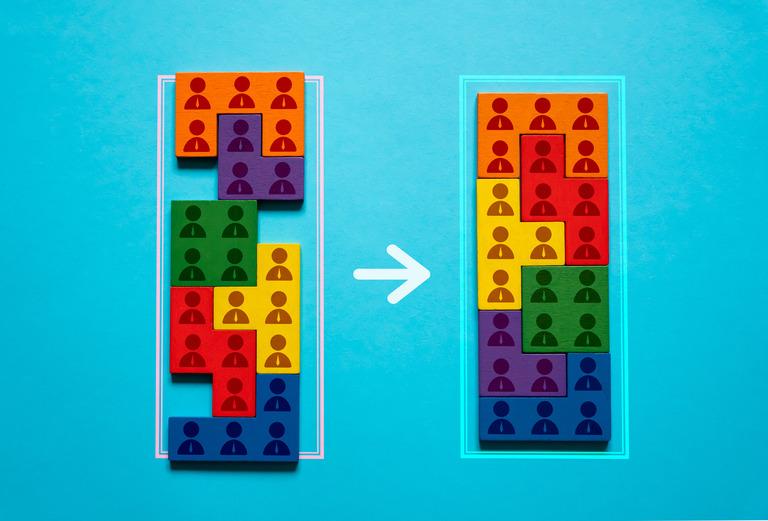
Engineering leadership | Blog Post
Software Development Agile Team Structure
Wes Mitchell-Lewis
Share this post
A software development team can be structured in a variety of ways. An increasingly common practice is the use of an agile team structure. Members of this type of team divide into smaller, interdisciplinary subgroups to tackle a project. The project is then completed by a number of groups, each of which is in charge of a specific subset of tasks.
Advantages of an Agile Software Engineering Organization Structure
For starters, it boosts interaction within groups. Since each team is in charge of a distinct aspect of the project, good communication is essential for everyone to pull their weight.
A second benefit is that it aids in maintaining project momentum. If one team falls behind, the others can pitch in to assist them to catch up. Last but not least, it promotes adaptive scheduling. Changes to the project can be implemented more smoothly inside an agile team structure.
Disadvantages of an Agile Team Structure
The first problem is that it’s not always clear who is accountable for what. It’s easy for details to get lost when numerous people are responsible for various aspects of the same project. Second, in a fast-paced workplace, it can be difficult to maintain concentration.
With so much occurring simultaneously, it’s simple to lose track of the greater picture. Finally, it can be challenging to keep track of everything that’s happening. Without good management, a large group of individuals working on a single project at the same time could create chaos.
The Basics of Software Development Team Structure
Choosing the organizational makeup of your development team is a crucial step in creating useful software. The optimum team structure for your needs will depend on the nature of the project, the amount of time available to finish it, and the amount of money set aside for development.
The Type and Complexity of Your Project
When putting together your team, the nature and scope of the project should come first. Whenever working on a massive, intricate project, it’s crucial that team members are able to communicate and collaborate well with one another.
Your project’s size and difficulty can be estimated more accurately if you split it down into smaller jobs and estimate how long it will take to accomplish each one individually.
The Time You Have to Complete the Project
When time is of the essence, you need a staff that can get things done fast and effectively. On the other hand, you can take your time doing the project if you have more leeway in your schedule.
The Budget Allocated to Development
The third consideration is the development budget. In order to complete your project within your financial constraints, you will need to assemble a group of people who are willing to do it for less pay—but if you have a larger budget, you can splurge on a more formidable group.
Approaches to Software Engineering Agile Team Structure
In software engineering, there are two main approaches to team structure—waterfall and agile. Both have their pros and cons, so it’s important to understand the differences between the two before deciding which one is right for your project.
Waterfall Team Structure
In a waterfall team structure, each team member has a specific role and responsibility. The project is completed in a linear fashion, with each task being completed before moving on to the next. This type of team structure is best suited for projects that are well-defined and have little room for change.
Pros:
- Clear roles and responsibilities make it easy to hold team members accountable
- A linear approach is easier to manage and plan
Cons:
- Little room for error or changes can make the project inflexible
- Dependence on other team members can slow down the project if one person falls behind
Agile Team Structure
In an agile team structure, the project is completed in small increments called “sprints.” Each sprint has its own goal, and the team works together to complete that goal within a set timeframe. This type of team structure is best suited for projects that are complex or may need to change during development.
Pros:
- Team members can work independently, which helps the project move forward even if one person falls behind
- Sprints allow for changes to be made mid-project without major disruptions
Cons:
- It can be difficult to track progress if the project goals are not well-defined
- Having too many people working independently can lead to confusion and a lack of accountability
Components of Software Engineering Agile Team Structure
In any software development project, there are a few key players that are essential to the success of the project. At a minimum, you will need a project manager, a business analyst, and a developer—but in larger projects, you may also need a quality assurance specialist, a database administrator, and a user experience designer. Let’s take a closer look at the different types of software development teams and the roles that each team member plays.
The Project Manager
The project manager is responsible for ensuring that the project is completed on time, within budget, and to the company’s specs. They are the ones who create the project schedule and assign tasks to team members. The project manager is also responsible for communication between the client and the development team.
The Business Analyst
The business analyst is responsible for understanding the client’s needs and requirements and translating them into technical specifications that the development team can use to build the software. They also play an important role in writing user stories, which help to define what features the software should have from the end-user’s perspective.
The Developer
Developers are responsible for writing the code that brings the software to life. They take the technical specifications from the business analyst and turn them into working code. In some cases, they may also be responsible for designing certain aspects of the user interface.
The Quality Assurance Specialist
The quality assurance specialist is responsible for testing the software to ensure that it meets all of the specified requirements and does not contain any bugs or errors. They create test plans and test cases that they then use to test various aspects of the software.
The Database Administrator
The database administrator is responsible for setting up and maintaining the databases that are used by the software. They ensure that data is stored securely and can be retrieved quickly when needed.
The User Experience Designer
The user experience designer is responsible for creating wireframes and prototypes that show how the user will interact with the software. They focus on making sure that the software is easy to use and has a clean design.
How Agile Team Structure Builds Success
A company’s organizational structure can have significant effects on its performance. In particular, how tasks are assigned within a team can be essential in determining its overall performance. Agile teams are organized in a way that allows for maximum adaptability and responsiveness, which are prerequisites for success in today’s dynamic corporate world.
In an agile setting, tasks are broken down into bite-sized chunks known as “stories.” Individual team members are tasked with completing specific subsets of each story. Members of the team can concentrate on a single assignment at a time rather than juggling a number of competing priorities.
They’re able to improve their productivity and output as a result. The ability to quickly adjust to new circumstances is crucial in today’s fast-paced corporate world, and the agile method facilitates this adaptation.
How to Assemble A Winning Software Team Agile Structure
The key to success for many businesses is a well-balanced team all pulling in the same direction. The same is true of teams working on software. You need to know the ins and outs of your organization and the function of each team member before you can put up a strong team structure.
Building a well-organized team is a surefire method to achieve your goals. This means that everyone on the team is contributing a unique set of abilities.
One team member could be in charge of coding, another would be in charge of testing, and yet another would be in charge of providing support. When everyone’s responsibilities are laid out in advance, the team can work together more efficiently.
Since everyone is on the same page, the team is able to accomplish more and collaborate more efficiently.
Another critical aspect of creating more than a typical software development team structure is to ensure that all members are able to work together harmoniously. This calls for honest dialogue and consideration of one another’s viewpoints. Having everyone on the team understand the project’s ultimate purpose is also crucial.
There is a higher chance of success for your team if everyone pitches in to help reach the same objective.
Continue to explore the rest of Terminal’s content offerings. If you are interested in learning more about how Terminal can support your organization and accomplish your development goals, please get in touch with our team!


